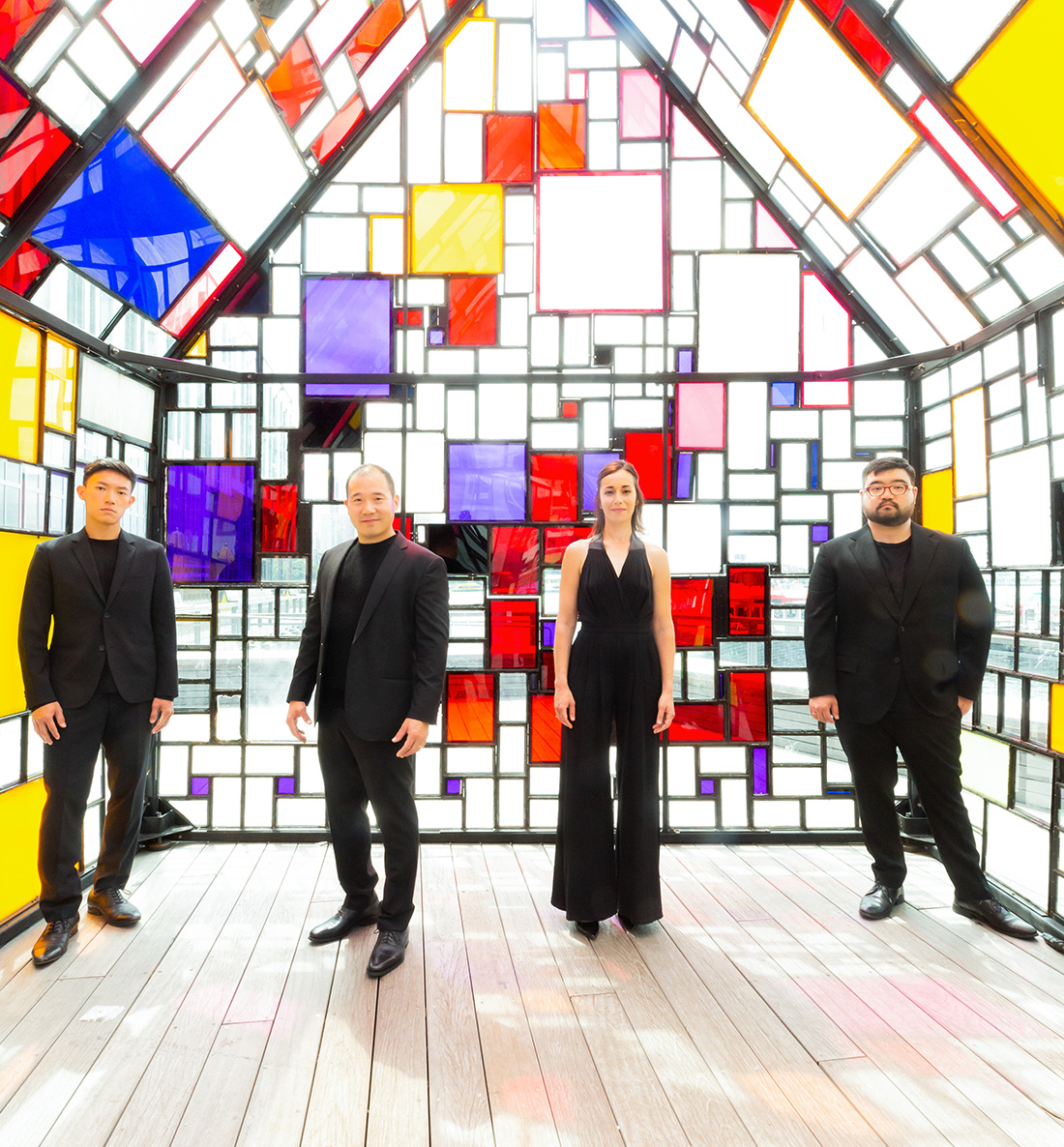“…exceptional virtuosity [and] imaginative interpretation.”-The Washington Post
Inspiring performances, luminous sound, and exceptional musicianship are the hallmarks of the GRAMMY Award-winning Parker Quartet. Renowned for its dynamic interpretations and polished, expansive colors, the group has rapidly distinguished itself as one of the preeminent ensembles of its generation, dedicated purely to the sound and depth of their music.
One of our favorite quartets, the Parker makes their fourth appearance at our series.
Caroline Shaw (b. 1982): Valencia
György Ligeti (1923—2006): String Quartet No. 2 (1968)
Allegro nervosa
Sostenuto, molto calmo
Come un meccanismo di precision
Presto furioso, brutale, tumultuoso
Allegro con delicatezza
— Intermission —
L. van Beethoven (1770—1827): String Quartet No. 7 in F Major, Op. 59, No. 1
Allegro
Allegretto vivace e sempre scherzando
Adagio molto e mesto – attacca
Théme russe. Allegro
Program is subject to change
Program Notes by Joe Gusmano
Caroline Shaw (1982 – ): Valencia
Shaw is an American composer, violinist, and vocalist. She is currently on faculty at NYU Steinhardt as an adjunct composition instructor and she has worked with a wide variety of musical artists, ranging from the Brentano String Quartet to Kanye West. Shaw began composing at the age of ten, emulating the melodies and textures of composers like Mozart, Haydn, and Brahms. As she developed her own compositional voice, she fused these melodic tendencies with more minimalist musical aesthetics.
Perhaps best known for her Pulitzer-prize winning acapella piece Partita, for 8 voices, Shaw composed Valencia as an homage to the orange. The subject of this quartet was inspired by the performance artist Glasser, who performed a piece about the simple beauty of fruit at a performance at the MoMA that Shaw attended in 2012. Shaw described this music as an “untethered embrace of the architecture of the common Valencia orange, through billowing harmonics and somewhat viscous chords and melodies.” The piece opens with a vivacious gesture in the upper strings, which play harmonics, a technique that requires a string player to lightly touch part of a string rather than pressing down on it entirely. This creates a light, airy pitch that would be otherwise too high to play using conventional fingerings. As the piece develops, the texture of the music becomes thick with deep, resonant chords that use a lot of open strings. The harmonics move from the violins down to the viola and cello, and the rhythmic motif from the beginning of the piece returns at its close.
György Ligeti (1923-2006): String Quartet No. 2
The Hungarian composer György Ligeti is one of the more influential avante-garde composers of the second half of the 20th century. He was born in Transylvania but emigrated to Austria to study music. Ligeti eventually went on to teach composition at the Hamburg Hochschule für Musik und Theater. Much of his work was suppressed by Soviet officials in Hungary, where in Germany he became much more experimental with his art. Ligeti is best known for his concept of micropolyphony, or the use of many different independent melodies moving at radically different pitches and rhythms, resulting in a dense polyphonic texture.
Throughout his life, Ligeti only composed three string quartets. His final quartet uses micropolyphony, but his first two quartets are inspired by Bela Bartók’s compositional style. The five movements of his second string quartet are vastly different from one another in terms of tempo, organization, and articulation. The first movement is structured into loose, broken up sections where the second movement is much slower and lyrical. The third movement is performed entirely using pizzicato, or plucked, attacks and is reminiscent of the fourth movement of Bartók’s fourth string quartet. The fourth movement of Ligeti’s quartet crams together the musical material from the previous movements into one lightning-fast burst of notes. The fifth movement, by contrast, is much slower and stretches the themes from the third movement into much longer phrases. This final movement gives a more clear context for the form of the entire piece.
Ludwig van Beethoven (1770-1827): String Quartet in F Major, Op. 59, No. 1
Beethoven composed this quartet in 1806 as part of a set of three quartets that were commissioned by the Russian ambassador to Vienna, Count Andreas Razumovsky. These quartets are known as Beethoven’s “Middle Period” quartets, along with op. 74 and 95. This first quartet is more technically challenging than his earlier quartets, and they demonstrate a clear departure from the traditional formal and melodic conventions of string quartet writing established by Classical composers like Haydn and Mozart. The three quartets from Op. 59 were initially received with some trepidation by listeners and performers, who no doubt bristled at the technical challenges and extended length of Beethoven’s more mature quartets. Eventually the public warmed up to the “Razumovsky” quartets, with one review published in 1807 saying, “The conception is profound and the construction excellent, but they are not easily comprehended.”
One significant challenge presented by the first of these quartets is the use of highly contrapuntal melodic writing, which appears towards the end of the first movement in the fugato section. Contrapuntal melodies involve two or more voices performing independent melodies at the same time. The second movement is no less daring and challenging. Beethoven gives the tempo marking “Allegro vivace e sempre scherzando,” which implies that the movement should maintain a light, tongue-in-cheek, and humorous character even as it spins into a tempestuous web of melodic figurations. He connects the dark, moody music of the third movement with the joyous fourth movement by way of a short musical segue between the two movements. The Russian theme in the final movement is no doubt an attempt by Beethoven to ingratiate himself to his benefactor.
Daniel Chong, violin
Ken Hamao, violin
Jessica Bodner, viola
Kee-Hyun Kim, cello
Inspiring performances, luminous sound, and exceptional musicianship are the hallmarks of the Grammy Award-winning Parker Quartet. Renowned for its dynamic interpretations and polished, expansive colors, the group has rapidly distinguished itself as one of the preeminent ensembles of its generation, dedicated purely to the sound and depth of their music. The Quartet has appeared at the world’s most important venues since its founding in 2002.
The Parker Quartet is now in its seventh year as faculty members of Harvard University’s Department of Music in the group’s role as Blodgett Artists-in-Residence. Recent seasons included performances and residencies around the United States and Europe, including at the University of Iowa, the University of Chicago, the Wigmore Hall, the University of South Carolina, the Schubert Club, Skidmore College, and Kansas City’s Friends of Chamber Music.
The Quartet has been influential in projects ranging from the premiere of a new octet by Zosha di Castri alongside the JACK Quartet at the Banff Centre for Arts and Creativity; to the premiere of Augusta Read Thomas’s Helix Spirals, a piece inspired by the Meselson-Stahl DNA replication discovery; to the “Schubert Effect,” in collaboration with pianist Shai Wosner at the 92nd Street Y. Other recent highlights include appearances at Carnegie Hall, the Library of Congress, the Slee Series in Buffalo, and New York’s Lincoln Center Great Performers series. The Quartet also continues to be a strong supporter of their friend and frequent collaborator Kim Kashkashian’s project Music for Food by participating in concerts throughout the United States for the benefit of various food banks and shelters.
The Quartet has been particularly focused on recording projects. They have recorded Dvořák’s Viola Quintet for ECM Records, joined by Kim Kashkashian, as well as Kurtag’s Six Moments Musicaux and Officium breve in memoriam. Under the auspices of the Monte Carlo Festival Printemps des Arts, they recorded a disc of three Beethoven quartets, released in the fall of 2019. The Quartet’s recording featuring Mendelssohn’s Quartets Op. 44, Nos. 1 and 3, was widely lauded by the international press, and their debut commercial recording of Bartók’s String Quartets Nos. 2 and 5 for Zig-Zag Territoires won praise from Gramophone: “The Parkers’ Bartók spins the illusion of spontaneous improvisation… they have absorbed the language; they have the confidence to play freely with the music and the instinct to bring it off.” Their Naxos recording of György Ligeti’s complete works for string quartet won the 2011 Grammy Award for Best Chamber Music Performance (the last string quartet to win this category).
Recent collaborations include those with acclaimed artists like violist Kim Kashkashian, featured on their recent Dvořák recording; violinist Nadja Salerno-Sonnenberg; pianists Anne-Marie McDermott, Orion Weiss, Vijay Iyer, and Shai Wosner; members of the Silk Road Ensemble; Kikuei Ikeda of the Tokyo String Quartet; clarinetist and composer Jörg Widmann; and clarinetists Anthony McGill and Charles Neidich.
Founded and currently based in Boston, the Parker Quartet’s numerous honors include winning the Concert Artists Guild Competition, the Grand Prix and Mozart Prize at France’s Bordeaux International String Quartet Competition, and Chamber Music America’s prestigious Cleveland Quartet Award. Now Blodgett Artists-in-Residence at Harvard University’s Department of Music, and also in-residence at the UofSC School of Music, the Quartet’s numerous residencies have included serving as Artists-in-Residence at the University of St. Thomas (2012–2014), Quartet-in-Residence at the University of Minnesota (2011– 2012), Quartet-in-Residence with the St. Paul Chamber Orchestra (2008-2010), and as the first-ever Artists-in-Residence with Minnesota Public Radio (2009-2010).
The Parker Quartet’s members hold graduate degrees in performance and chamber music from the New England Conservatory of Music and the Juilliard School, and the Quartet was part of the New England Conservatory’s prestigious Professional String Quartet Training Program from 2006–2008. Some of their most influential mentors include the original members of the Cleveland Quartet as well as Kim Kashkashian, György Kurtág, and Rainer Schmidt.




